Public Health: Analysis of Clinical Governance Failings in Hospitals
VerifiedAdded on 2023/06/05
|7
|1754
|157
Report
AI Summary
This report provides an in-depth analysis of clinical governance failings within healthcare, using the Bundaberg Hospital incident as a case study. The report identifies key failures, including lack of organizational congruence, overlooking patient complaints, substandard care, bullying, poor communication, and weak organizational culture. It explores the impact of these failings on patient safety and ethical decision-making. The report then examines governance mechanisms that could have prevented these incidents, such as a healthy organizational culture, ethical decision-making, proper reporting of adverse events, and patient involvement in decision-making. The conclusion highlights the importance of organizational culture, leadership, and shared decision-making as key elements for improving healthcare quality and patient safety. The report references several academic sources to support its findings, providing a comprehensive overview of the topic.
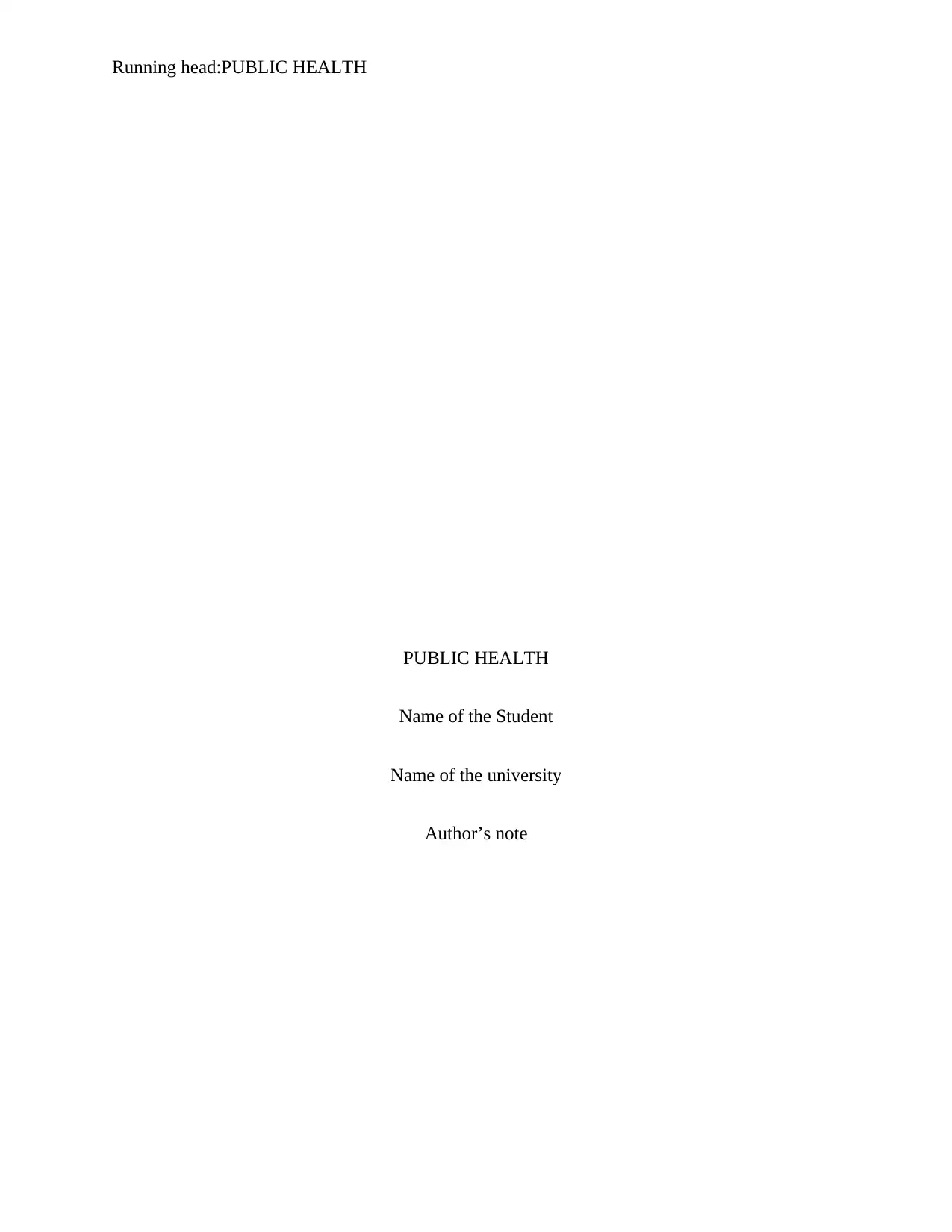
Running head:PUBLIC HEALTH
PUBLIC HEALTH
Name of the Student
Name of the university
Author’s note
PUBLIC HEALTH
Name of the Student
Name of the university
Author’s note
Paraphrase This Document
Need a fresh take? Get an instant paraphrase of this document with our AI Paraphraser
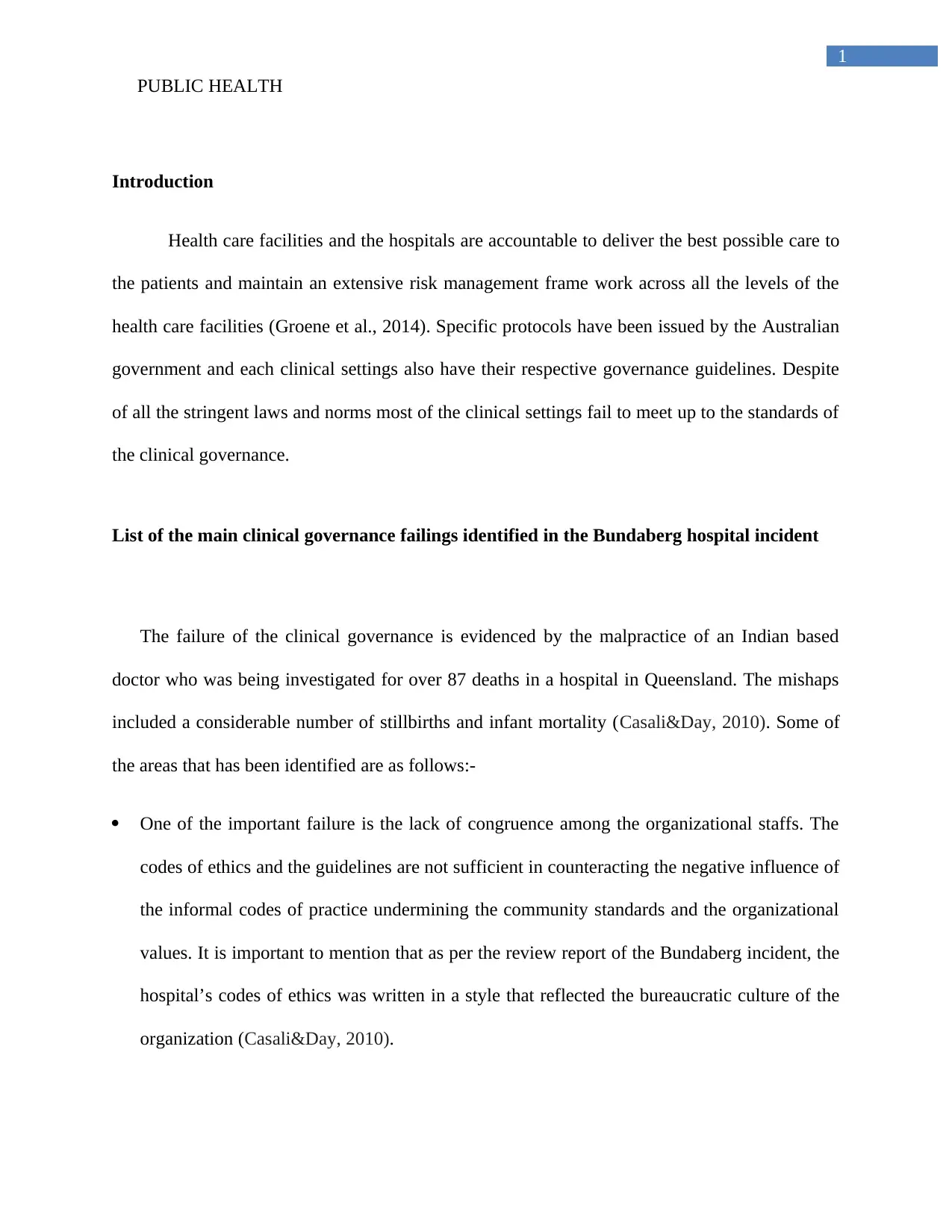
1
PUBLIC HEALTH
Introduction
Health care facilities and the hospitals are accountable to deliver the best possible care to
the patients and maintain an extensive risk management frame work across all the levels of the
health care facilities (Groene et al., 2014). Specific protocols have been issued by the Australian
government and each clinical settings also have their respective governance guidelines. Despite
of all the stringent laws and norms most of the clinical settings fail to meet up to the standards of
the clinical governance.
List of the main clinical governance failings identified in the Bundaberg hospital incident
The failure of the clinical governance is evidenced by the malpractice of an Indian based
doctor who was being investigated for over 87 deaths in a hospital in Queensland. The mishaps
included a considerable number of stillbirths and infant mortality (Casali&Day, 2010). Some of
the areas that has been identified are as follows:-
One of the important failure is the lack of congruence among the organizational staffs. The
codes of ethics and the guidelines are not sufficient in counteracting the negative influence of
the informal codes of practice undermining the community standards and the organizational
values. It is important to mention that as per the review report of the Bundaberg incident, the
hospital’s codes of ethics was written in a style that reflected the bureaucratic culture of the
organization (Casali&Day, 2010).
PUBLIC HEALTH
Introduction
Health care facilities and the hospitals are accountable to deliver the best possible care to
the patients and maintain an extensive risk management frame work across all the levels of the
health care facilities (Groene et al., 2014). Specific protocols have been issued by the Australian
government and each clinical settings also have their respective governance guidelines. Despite
of all the stringent laws and norms most of the clinical settings fail to meet up to the standards of
the clinical governance.
List of the main clinical governance failings identified in the Bundaberg hospital incident
The failure of the clinical governance is evidenced by the malpractice of an Indian based
doctor who was being investigated for over 87 deaths in a hospital in Queensland. The mishaps
included a considerable number of stillbirths and infant mortality (Casali&Day, 2010). Some of
the areas that has been identified are as follows:-
One of the important failure is the lack of congruence among the organizational staffs. The
codes of ethics and the guidelines are not sufficient in counteracting the negative influence of
the informal codes of practice undermining the community standards and the organizational
values. It is important to mention that as per the review report of the Bundaberg incident, the
hospital’s codes of ethics was written in a style that reflected the bureaucratic culture of the
organization (Casali&Day, 2010).
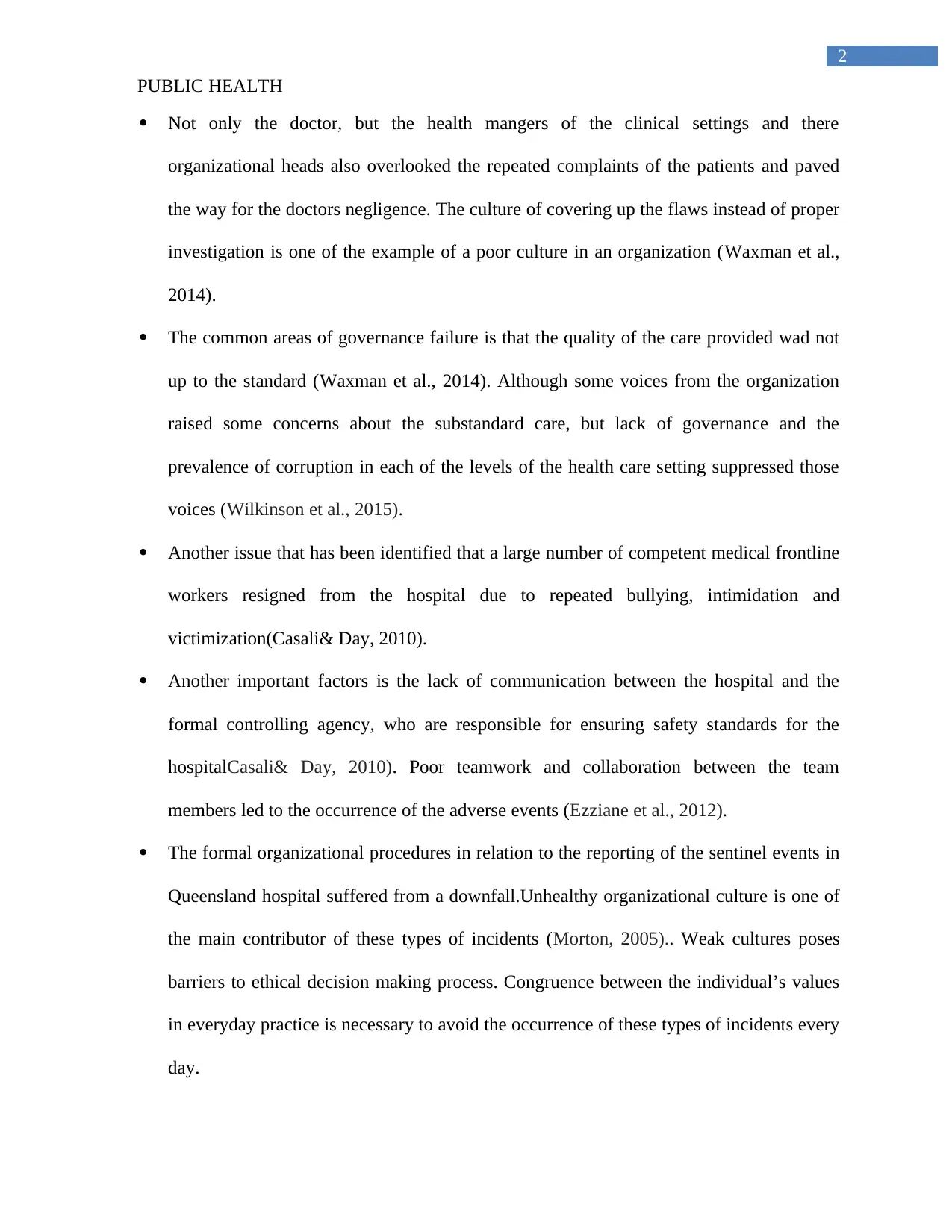
2
PUBLIC HEALTH
Not only the doctor, but the health mangers of the clinical settings and there
organizational heads also overlooked the repeated complaints of the patients and paved
the way for the doctors negligence. The culture of covering up the flaws instead of proper
investigation is one of the example of a poor culture in an organization (Waxman et al.,
2014).
The common areas of governance failure is that the quality of the care provided wad not
up to the standard (Waxman et al., 2014). Although some voices from the organization
raised some concerns about the substandard care, but lack of governance and the
prevalence of corruption in each of the levels of the health care setting suppressed those
voices (Wilkinson et al., 2015).
Another issue that has been identified that a large number of competent medical frontline
workers resigned from the hospital due to repeated bullying, intimidation and
victimization(Casali& Day, 2010).
Another important factors is the lack of communication between the hospital and the
formal controlling agency, who are responsible for ensuring safety standards for the
hospitalCasali& Day, 2010). Poor teamwork and collaboration between the team
members led to the occurrence of the adverse events (Ezziane et al., 2012).
The formal organizational procedures in relation to the reporting of the sentinel events in
Queensland hospital suffered from a downfall.Unhealthy organizational culture is one of
the main contributor of these types of incidents (Morton, 2005).. Weak cultures poses
barriers to ethical decision making process. Congruence between the individual’s values
in everyday practice is necessary to avoid the occurrence of these types of incidents every
day.
PUBLIC HEALTH
Not only the doctor, but the health mangers of the clinical settings and there
organizational heads also overlooked the repeated complaints of the patients and paved
the way for the doctors negligence. The culture of covering up the flaws instead of proper
investigation is one of the example of a poor culture in an organization (Waxman et al.,
2014).
The common areas of governance failure is that the quality of the care provided wad not
up to the standard (Waxman et al., 2014). Although some voices from the organization
raised some concerns about the substandard care, but lack of governance and the
prevalence of corruption in each of the levels of the health care setting suppressed those
voices (Wilkinson et al., 2015).
Another issue that has been identified that a large number of competent medical frontline
workers resigned from the hospital due to repeated bullying, intimidation and
victimization(Casali& Day, 2010).
Another important factors is the lack of communication between the hospital and the
formal controlling agency, who are responsible for ensuring safety standards for the
hospitalCasali& Day, 2010). Poor teamwork and collaboration between the team
members led to the occurrence of the adverse events (Ezziane et al., 2012).
The formal organizational procedures in relation to the reporting of the sentinel events in
Queensland hospital suffered from a downfall.Unhealthy organizational culture is one of
the main contributor of these types of incidents (Morton, 2005).. Weak cultures poses
barriers to ethical decision making process. Congruence between the individual’s values
in everyday practice is necessary to avoid the occurrence of these types of incidents every
day.
⊘ This is a preview!⊘
Do you want full access?
Subscribe today to unlock all pages.

Trusted by 1+ million students worldwide
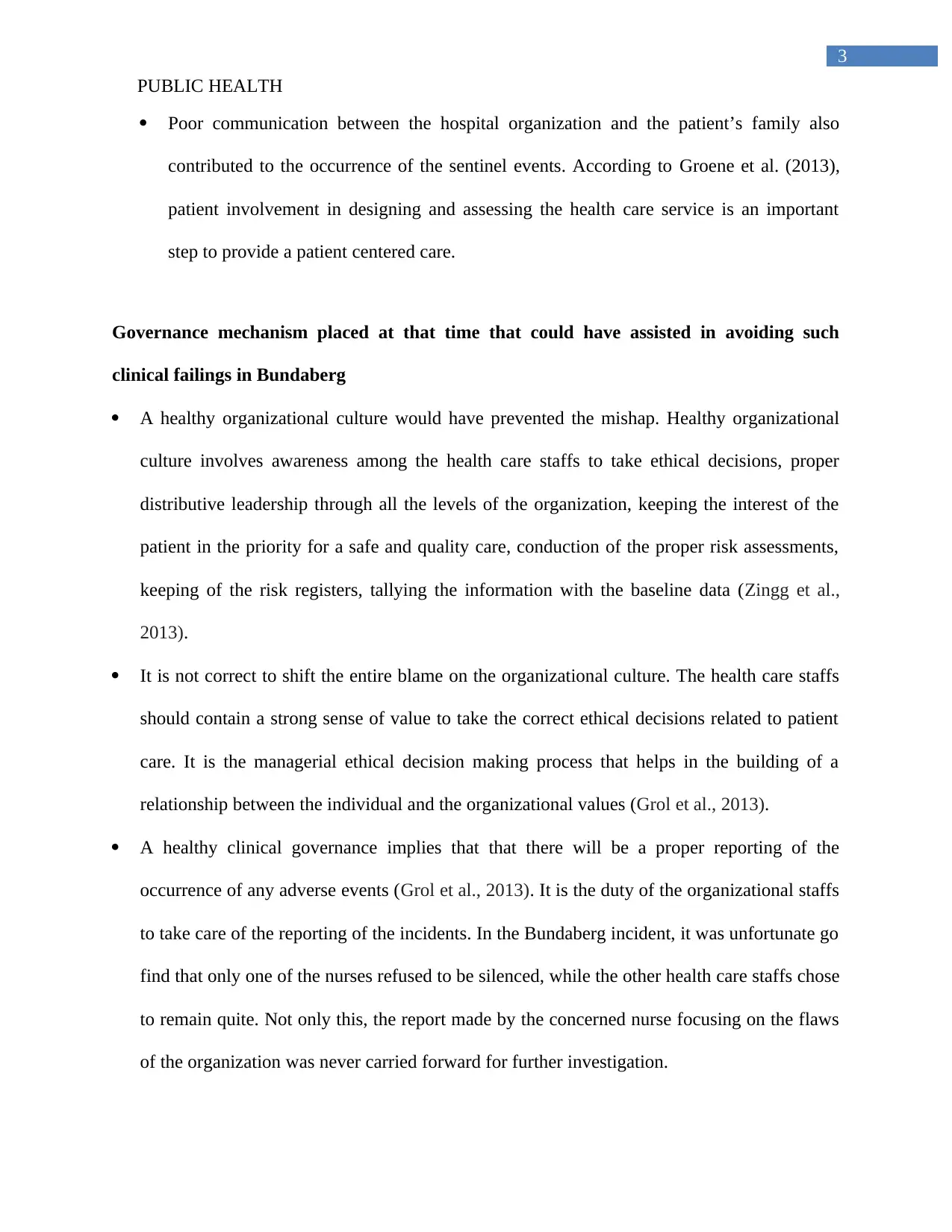
3
PUBLIC HEALTH
Poor communication between the hospital organization and the patient’s family also
contributed to the occurrence of the sentinel events. According to Groene et al. (2013),
patient involvement in designing and assessing the health care service is an important
step to provide a patient centered care.
Governance mechanism placed at that time that could have assisted in avoiding such
clinical failings in Bundaberg
A healthy organizational culture would have prevented the mishap. Healthy organizational
culture involves awareness among the health care staffs to take ethical decisions, proper
distributive leadership through all the levels of the organization, keeping the interest of the
patient in the priority for a safe and quality care, conduction of the proper risk assessments,
keeping of the risk registers, tallying the information with the baseline data (Zingg et al.,
2013).
It is not correct to shift the entire blame on the organizational culture. The health care staffs
should contain a strong sense of value to take the correct ethical decisions related to patient
care. It is the managerial ethical decision making process that helps in the building of a
relationship between the individual and the organizational values (Grol et al., 2013).
A healthy clinical governance implies that that there will be a proper reporting of the
occurrence of any adverse events (Grol et al., 2013). It is the duty of the organizational staffs
to take care of the reporting of the incidents. In the Bundaberg incident, it was unfortunate go
find that only one of the nurses refused to be silenced, while the other health care staffs chose
to remain quite. Not only this, the report made by the concerned nurse focusing on the flaws
of the organization was never carried forward for further investigation.
PUBLIC HEALTH
Poor communication between the hospital organization and the patient’s family also
contributed to the occurrence of the sentinel events. According to Groene et al. (2013),
patient involvement in designing and assessing the health care service is an important
step to provide a patient centered care.
Governance mechanism placed at that time that could have assisted in avoiding such
clinical failings in Bundaberg
A healthy organizational culture would have prevented the mishap. Healthy organizational
culture involves awareness among the health care staffs to take ethical decisions, proper
distributive leadership through all the levels of the organization, keeping the interest of the
patient in the priority for a safe and quality care, conduction of the proper risk assessments,
keeping of the risk registers, tallying the information with the baseline data (Zingg et al.,
2013).
It is not correct to shift the entire blame on the organizational culture. The health care staffs
should contain a strong sense of value to take the correct ethical decisions related to patient
care. It is the managerial ethical decision making process that helps in the building of a
relationship between the individual and the organizational values (Grol et al., 2013).
A healthy clinical governance implies that that there will be a proper reporting of the
occurrence of any adverse events (Grol et al., 2013). It is the duty of the organizational staffs
to take care of the reporting of the incidents. In the Bundaberg incident, it was unfortunate go
find that only one of the nurses refused to be silenced, while the other health care staffs chose
to remain quite. Not only this, the report made by the concerned nurse focusing on the flaws
of the organization was never carried forward for further investigation.
Paraphrase This Document
Need a fresh take? Get an instant paraphrase of this document with our AI Paraphraser
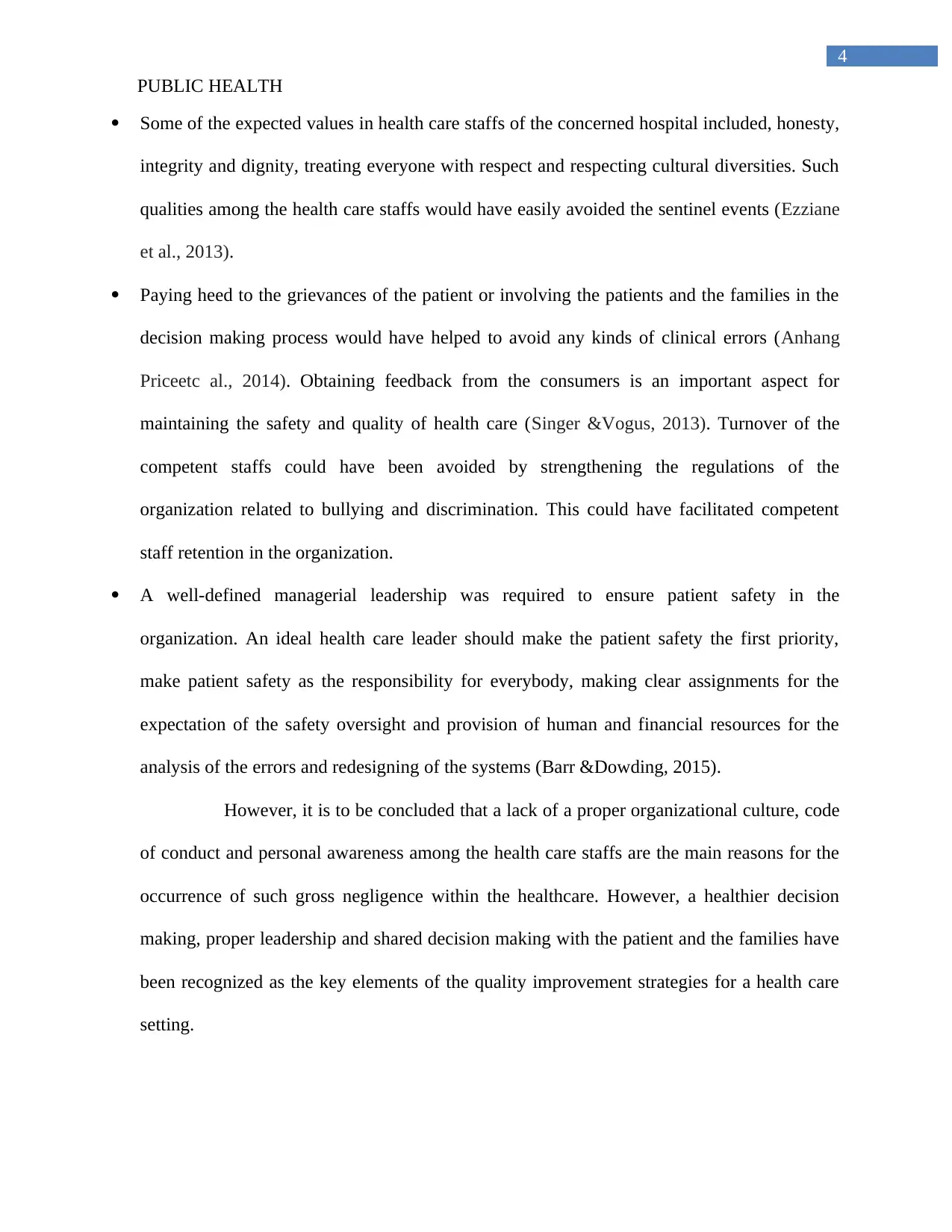
4
PUBLIC HEALTH
Some of the expected values in health care staffs of the concerned hospital included, honesty,
integrity and dignity, treating everyone with respect and respecting cultural diversities. Such
qualities among the health care staffs would have easily avoided the sentinel events (Ezziane
et al., 2013).
Paying heed to the grievances of the patient or involving the patients and the families in the
decision making process would have helped to avoid any kinds of clinical errors (Anhang
Priceetc al., 2014). Obtaining feedback from the consumers is an important aspect for
maintaining the safety and quality of health care (Singer &Vogus, 2013). Turnover of the
competent staffs could have been avoided by strengthening the regulations of the
organization related to bullying and discrimination. This could have facilitated competent
staff retention in the organization.
A well-defined managerial leadership was required to ensure patient safety in the
organization. An ideal health care leader should make the patient safety the first priority,
make patient safety as the responsibility for everybody, making clear assignments for the
expectation of the safety oversight and provision of human and financial resources for the
analysis of the errors and redesigning of the systems (Barr &Dowding, 2015).
However, it is to be concluded that a lack of a proper organizational culture, code
of conduct and personal awareness among the health care staffs are the main reasons for the
occurrence of such gross negligence within the healthcare. However, a healthier decision
making, proper leadership and shared decision making with the patient and the families have
been recognized as the key elements of the quality improvement strategies for a health care
setting.
PUBLIC HEALTH
Some of the expected values in health care staffs of the concerned hospital included, honesty,
integrity and dignity, treating everyone with respect and respecting cultural diversities. Such
qualities among the health care staffs would have easily avoided the sentinel events (Ezziane
et al., 2013).
Paying heed to the grievances of the patient or involving the patients and the families in the
decision making process would have helped to avoid any kinds of clinical errors (Anhang
Priceetc al., 2014). Obtaining feedback from the consumers is an important aspect for
maintaining the safety and quality of health care (Singer &Vogus, 2013). Turnover of the
competent staffs could have been avoided by strengthening the regulations of the
organization related to bullying and discrimination. This could have facilitated competent
staff retention in the organization.
A well-defined managerial leadership was required to ensure patient safety in the
organization. An ideal health care leader should make the patient safety the first priority,
make patient safety as the responsibility for everybody, making clear assignments for the
expectation of the safety oversight and provision of human and financial resources for the
analysis of the errors and redesigning of the systems (Barr &Dowding, 2015).
However, it is to be concluded that a lack of a proper organizational culture, code
of conduct and personal awareness among the health care staffs are the main reasons for the
occurrence of such gross negligence within the healthcare. However, a healthier decision
making, proper leadership and shared decision making with the patient and the families have
been recognized as the key elements of the quality improvement strategies for a health care
setting.
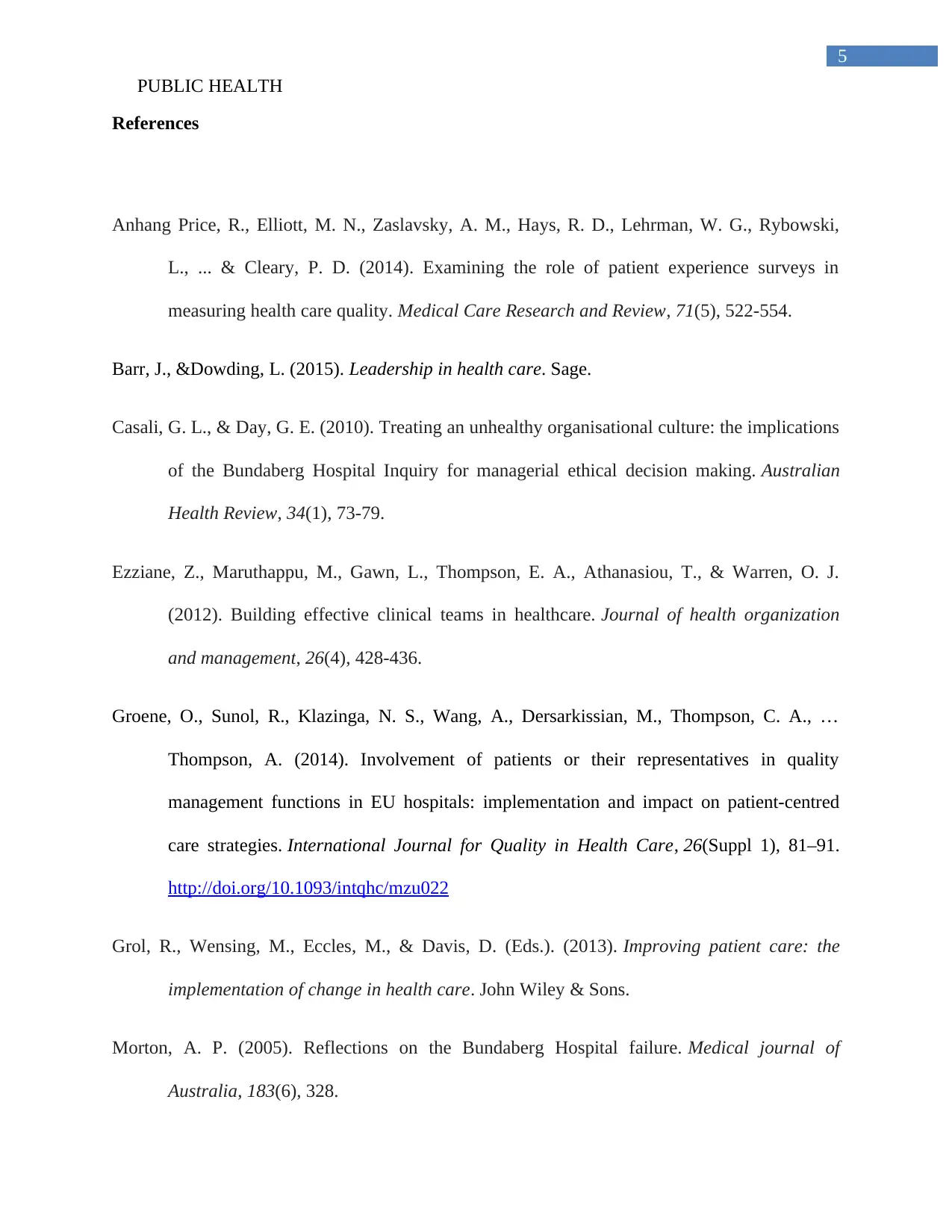
5
PUBLIC HEALTH
References
Anhang Price, R., Elliott, M. N., Zaslavsky, A. M., Hays, R. D., Lehrman, W. G., Rybowski,
L., ... & Cleary, P. D. (2014). Examining the role of patient experience surveys in
measuring health care quality. Medical Care Research and Review, 71(5), 522-554.
Barr, J., &Dowding, L. (2015). Leadership in health care. Sage.
Casali, G. L., & Day, G. E. (2010). Treating an unhealthy organisational culture: the implications
of the Bundaberg Hospital Inquiry for managerial ethical decision making. Australian
Health Review, 34(1), 73-79.
Ezziane, Z., Maruthappu, M., Gawn, L., Thompson, E. A., Athanasiou, T., & Warren, O. J.
(2012). Building effective clinical teams in healthcare. Journal of health organization
and management, 26(4), 428-436.
Groene, O., Sunol, R., Klazinga, N. S., Wang, A., Dersarkissian, M., Thompson, C. A., …
Thompson, A. (2014). Involvement of patients or their representatives in quality
management functions in EU hospitals: implementation and impact on patient-centred
care strategies. International Journal for Quality in Health Care, 26(Suppl 1), 81–91.
http://doi.org/10.1093/intqhc/mzu022
Grol, R., Wensing, M., Eccles, M., & Davis, D. (Eds.). (2013). Improving patient care: the
implementation of change in health care. John Wiley & Sons.
Morton, A. P. (2005). Reflections on the Bundaberg Hospital failure. Medical journal of
Australia, 183(6), 328.
PUBLIC HEALTH
References
Anhang Price, R., Elliott, M. N., Zaslavsky, A. M., Hays, R. D., Lehrman, W. G., Rybowski,
L., ... & Cleary, P. D. (2014). Examining the role of patient experience surveys in
measuring health care quality. Medical Care Research and Review, 71(5), 522-554.
Barr, J., &Dowding, L. (2015). Leadership in health care. Sage.
Casali, G. L., & Day, G. E. (2010). Treating an unhealthy organisational culture: the implications
of the Bundaberg Hospital Inquiry for managerial ethical decision making. Australian
Health Review, 34(1), 73-79.
Ezziane, Z., Maruthappu, M., Gawn, L., Thompson, E. A., Athanasiou, T., & Warren, O. J.
(2012). Building effective clinical teams in healthcare. Journal of health organization
and management, 26(4), 428-436.
Groene, O., Sunol, R., Klazinga, N. S., Wang, A., Dersarkissian, M., Thompson, C. A., …
Thompson, A. (2014). Involvement of patients or their representatives in quality
management functions in EU hospitals: implementation and impact on patient-centred
care strategies. International Journal for Quality in Health Care, 26(Suppl 1), 81–91.
http://doi.org/10.1093/intqhc/mzu022
Grol, R., Wensing, M., Eccles, M., & Davis, D. (Eds.). (2013). Improving patient care: the
implementation of change in health care. John Wiley & Sons.
Morton, A. P. (2005). Reflections on the Bundaberg Hospital failure. Medical journal of
Australia, 183(6), 328.
⊘ This is a preview!⊘
Do you want full access?
Subscribe today to unlock all pages.

Trusted by 1+ million students worldwide
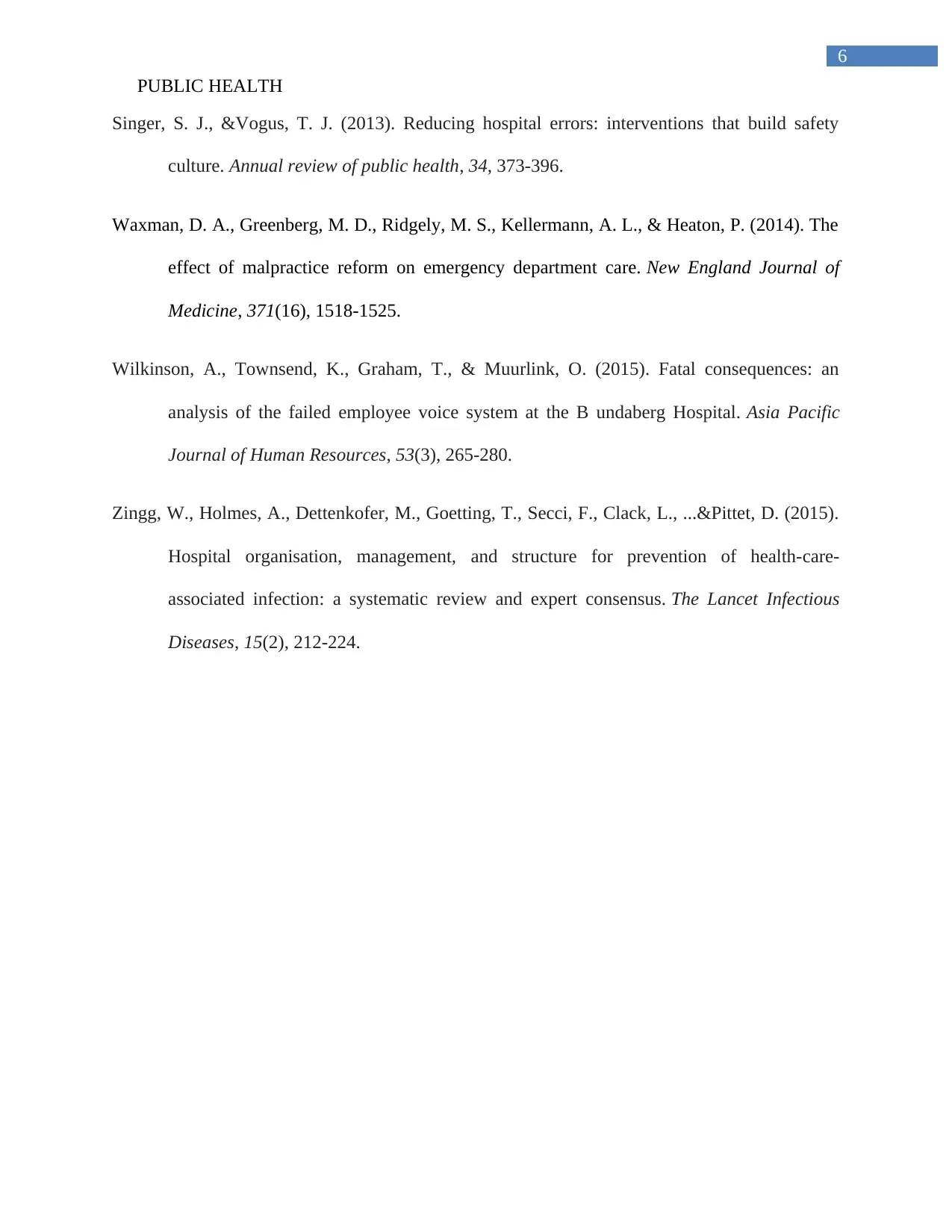
6
PUBLIC HEALTH
Singer, S. J., &Vogus, T. J. (2013). Reducing hospital errors: interventions that build safety
culture. Annual review of public health, 34, 373-396.
Waxman, D. A., Greenberg, M. D., Ridgely, M. S., Kellermann, A. L., & Heaton, P. (2014). The
effect of malpractice reform on emergency department care. New England Journal of
Medicine, 371(16), 1518-1525.
Wilkinson, A., Townsend, K., Graham, T., & Muurlink, O. (2015). Fatal consequences: an
analysis of the failed employee voice system at the B undaberg Hospital. Asia Pacific
Journal of Human Resources, 53(3), 265-280.
Zingg, W., Holmes, A., Dettenkofer, M., Goetting, T., Secci, F., Clack, L., ...&Pittet, D. (2015).
Hospital organisation, management, and structure for prevention of health-care-
associated infection: a systematic review and expert consensus. The Lancet Infectious
Diseases, 15(2), 212-224.
PUBLIC HEALTH
Singer, S. J., &Vogus, T. J. (2013). Reducing hospital errors: interventions that build safety
culture. Annual review of public health, 34, 373-396.
Waxman, D. A., Greenberg, M. D., Ridgely, M. S., Kellermann, A. L., & Heaton, P. (2014). The
effect of malpractice reform on emergency department care. New England Journal of
Medicine, 371(16), 1518-1525.
Wilkinson, A., Townsend, K., Graham, T., & Muurlink, O. (2015). Fatal consequences: an
analysis of the failed employee voice system at the B undaberg Hospital. Asia Pacific
Journal of Human Resources, 53(3), 265-280.
Zingg, W., Holmes, A., Dettenkofer, M., Goetting, T., Secci, F., Clack, L., ...&Pittet, D. (2015).
Hospital organisation, management, and structure for prevention of health-care-
associated infection: a systematic review and expert consensus. The Lancet Infectious
Diseases, 15(2), 212-224.
1 out of 7
Related Documents
Your All-in-One AI-Powered Toolkit for Academic Success.
+13062052269
info@desklib.com
Available 24*7 on WhatsApp / Email
![[object Object]](/_next/static/media/star-bottom.7253800d.svg)
Unlock your academic potential
Copyright © 2020–2025 A2Z Services. All Rights Reserved. Developed and managed by ZUCOL.





